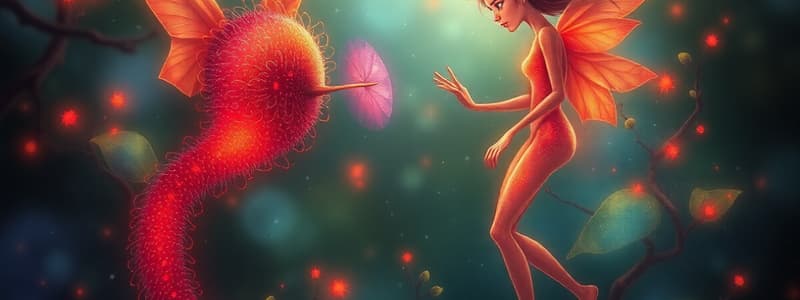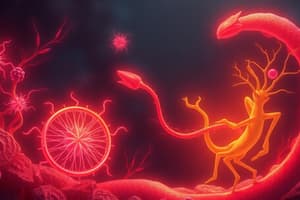Podcast
Questions and Answers
Which group of mammals is known to develop embryos inside the mother?
Which group of mammals is known to develop embryos inside the mother?
- Eutherians (correct)
- Monotremes
- Marsupials (correct)
- Reptiles
What is the function of the seminal vesicle in male insects?
What is the function of the seminal vesicle in male insects?
- To transport sperm to the vagina
- To produce eggs
- To store sperm (correct)
- To produce protective secretions
In the reproductive system of female insects, where do eggs develop?
In the reproductive system of female insects, where do eggs develop?
- Vagina
- Accessory glands
- Oviduct
- Ovaries (correct)
What role do accessory glands play in female insects after mating?
What role do accessory glands play in female insects after mating?
How is sperm stored in female insects following mating?
How is sperm stored in female insects following mating?
What type of reproduction involves the fusion of male and female gametes?
What type of reproduction involves the fusion of male and female gametes?
Which mechanism of asexual reproduction involves a parent organism separating into two or more individuals of similar size?
Which mechanism of asexual reproduction involves a parent organism separating into two or more individuals of similar size?
What is a distinguishing characteristic of semelparity in reproductive strategies?
What is a distinguishing characteristic of semelparity in reproductive strategies?
Which type of fertilization occurs when eggs are fertilized in the external environment?
Which type of fertilization occurs when eggs are fertilized in the external environment?
What term describes organisms that produce eggs that hatch inside the mother's uterus?
What term describes organisms that produce eggs that hatch inside the mother's uterus?
In which type of hermaphroditism can an organism self-fertilize?
In which type of hermaphroditism can an organism self-fertilize?
Which of the following describes a characteristic of internal fertilization?
Which of the following describes a characteristic of internal fertilization?
What is the primary difference between oviparity and viviparity?
What is the primary difference between oviparity and viviparity?
Which reproductive strategy typically involves multiple reproductive episodes throughout an organism's life span?
Which reproductive strategy typically involves multiple reproductive episodes throughout an organism's life span?
What type of gamete is produced by the female's reproductive organs?
What type of gamete is produced by the female's reproductive organs?
What is the primary function of estrogen in the female reproductive system?
What is the primary function of estrogen in the female reproductive system?
What happens to the corpus luteum if fertilization does not occur?
What happens to the corpus luteum if fertilization does not occur?
What initiates the transformation of the corpus luteum after ovulation?
What initiates the transformation of the corpus luteum after ovulation?
Which structure is responsible for conveying the egg to the uterus?
Which structure is responsible for conveying the egg to the uterus?
What triggers the release of calcium from internal organelles in the egg during fertilization?
What triggers the release of calcium from internal organelles in the egg during fertilization?
What role do estrogens secreted by the corpus luteum play in the uterus?
What role do estrogens secreted by the corpus luteum play in the uterus?
During which phase of the ovarian cycle does ovulation occur?
During which phase of the ovarian cycle does ovulation occur?
What is the acrosome reaction essential for during fertilization?
What is the acrosome reaction essential for during fertilization?
What role do the seminal vesicles play in male reproduction?
What role do the seminal vesicles play in male reproduction?
What occurs during ovulation?
What occurs during ovulation?
What is the function of the bulbourethral gland?
What is the function of the bulbourethral gland?
Which of the following statements is true about oogenesis?
Which of the following statements is true about oogenesis?
Where does sperm maturation primarily occur?
Where does sperm maturation primarily occur?
Which component is NOT part of semen?
Which component is NOT part of semen?
What is the main function of testosterone in males?
What is the main function of testosterone in males?
What happens to the primary oocyte during ovulation?
What happens to the primary oocyte during ovulation?
Which structure is responsible for the production of sperm in males?
Which structure is responsible for the production of sperm in males?
Which of the following glands secretes its products directly into the urethra?
Which of the following glands secretes its products directly into the urethra?
Flashcards
Embryonic Development
Embryonic Development
The development of a young organism within the mother's body.
Viviparous Mammals
Viviparous Mammals
All mammals except for monotremes, which are egg-laying mammals.
Insect Reproduction
Insect Reproduction
Insects have distinct male and female individuals with specialized reproductive organs.
Testis (Insect)
Testis (Insect)
Signup and view all the flashcards
Spermatheca
Spermatheca
Signup and view all the flashcards
Asexual Reproduction
Asexual Reproduction
Signup and view all the flashcards
Sexual Reproduction
Sexual Reproduction
Signup and view all the flashcards
Fission
Fission
Signup and view all the flashcards
Budding
Budding
Signup and view all the flashcards
Fragmentation
Fragmentation
Signup and view all the flashcards
Parthenogenesis
Parthenogenesis
Signup and view all the flashcards
Semelparity
Semelparity
Signup and view all the flashcards
Iteroparity
Iteroparity
Signup and view all the flashcards
External Fertilization
External Fertilization
Signup and view all the flashcards
Internal Fertilization
Internal Fertilization
Signup and view all the flashcards
Testes
Testes
Signup and view all the flashcards
Seminiferous Tubules
Seminiferous Tubules
Signup and view all the flashcards
Epididymis
Epididymis
Signup and view all the flashcards
Vas Deferens
Vas Deferens
Signup and view all the flashcards
Seminal Vesicle
Seminal Vesicle
Signup and view all the flashcards
Prostate Gland
Prostate Gland
Signup and view all the flashcards
Bulbourethral Gland
Bulbourethral Gland
Signup and view all the flashcards
Semen
Semen
Signup and view all the flashcards
Testosterone
Testosterone
Signup and view all the flashcards
Spermatogenesis
Spermatogenesis
Signup and view all the flashcards
Estrogen
Estrogen
Signup and view all the flashcards
Progesterone
Progesterone
Signup and view all the flashcards
Ovulation
Ovulation
Signup and view all the flashcards
Corpus luteum
Corpus luteum
Signup and view all the flashcards
Luteal phase
Luteal phase
Signup and view all the flashcards
Fertilization
Fertilization
Signup and view all the flashcards
Acrosome reaction
Acrosome reaction
Signup and view all the flashcards
Meiosis
Meiosis
Signup and view all the flashcards
Study Notes
Reproduction
- Reproduction is the production of offspring either sexually or asexually.
- Asexual reproduction needs only one parent organism.
- Sexual reproduction requires two parent organisms, male (sperm) and female (egg) gametes, to form a zygote.
Asexual Reproduction Mechanisms
- Many invertebrates reproduce asexually via fission.
- Fission is the separation of a parent into two or more individuals of approximately the same size.
- Other common asexual reproduction mechanisms in invertebrates include budding and fragmentation.
- Parthenogenesis is a type of asexual reproduction where an egg develops without being fertilized.
Sexual Reproduction
- Sexual reproduction involves two parents.
- Each parent has reproductive organs that produce gametes (reproductive cells).
- Males have testes that produce sperm.
- Females have ovaries that produce ova (eggs).
Reproduction Strategies
- Internal fertilization involves sperm being deposited in or near the female reproductive tract.
- External fertilization involves eggs being shed by the female and fertilized by sperm in the external environment.
- Semelparity is a reproductive strategy where organisms have a single reproductive episode before death (e.g., octopus, mayfly, salmon, antechinuses).
- Iteroparity is a reproductive strategy allowing for multiple reproductive episodes over an organism's life span (e.g., most animals).
Reproductive Cycles and Patterns
- Most animals exhibit cycles in reproductive activity often related to changing seasons.
- These cycles are controlled by hormones and environmental cues.
Hermaphroditism
- Simultaneous hermaphrodites have both male and female reproductive organs with self-fertilization possible.
- Bluehead wrasses are an example of sequential hermaphrodites; they begin as males and later change their sex to female.
Mammalian Reproduction (Males)
- The male gonads (testes) consist of coiled tubes (seminiferous tubules).
- Sperm is formed within the seminiferous tubules.
- During ejaculation, sperm are propelled through the vas deferens, ejaculatory duct, and urethra to exit through the penis.
Mammalian Reproduction (Males): Accessory Glands
- There are three accessory glands.
- The seminal vesicles contribute about 60% of semen volume.
- The prostate gland secretes fluids into the urethra.
- The bulbourethral glands secrete a mucus before ejaculation that neutralizes acidic urine.
Spermatogenesis
- Spermatogenesis is the process of sperm cell formation in males.
- It involves mitosis and meiosis.
- It produces mature sperm from spermatogonia.
Female Reproductive Organs: Ovary
- The ovaries are the female gonads located in the abdominal cavity.
- Each ovary contains many follicles consisting of one egg cell surrounded by protective follicle cells.
- Ovulation is the release of an egg cell from a follicle.
- The remaining follicular tissue forms a corpus luteum, which secretes hormones.
Oogenesis
- Oogenesis is the process of egg cell formation in females.
- It also involves mitosis and meiosis.
- Oogenesis usually begins before birth but is completed only after fertilization.
Ovaries. Hormones
- Ovaries produce hormones like estrogen and progesterone, playing critical roles in ovulation, pregnancy, and uterine preparation.
Oviducts and Uterus
- The egg is released into the abdominal cavity, near the opening of the oviduct (fallopian tube).
- Cilia in the oviduct convey the egg to the uterus.
Ovarian Cycle
- Ovulation marks the end of the follicular phase and the start of the luteal phase.
- The ovarian cycle is controlled by hormonal fluctuations.
Luteal Phase
- The cells of the ruptured follicle form the corpus luteum after ovulation.
- LH helps initiate the corpus luteum's transformation, and if the egg is not fertilized, the luteum degenerates.
- If fertilization happens, the corpus luteum continues to function, secreting hormones like progesterone and estrogen.
Fertilization
- Acrosome reaction activates the egg.
- Sperm contact with the egg's plasma membrane triggers calcium release, triggering changes in the egg's membrane potential to prevent other sperm from fusing with the egg.
Gamete Production: Meiosis
- Both oogenesis and spermatogenesis involve mitosis and meiosis.
- The processes differ in their timing and the number of functional gametes produced.
Revision Questions
- Name some forms of asexual reproduction (e.g., fission, budding, fragmentation, parthenogenesis).
- Describe the process of oogenesis and ovulation.
- List the male's external and internal reproductive organs.
Acknowledgements
- The majority of text and PowerPoint slides come from Campbell's Biology.
- Dr. Javier delBarco-Trillo from the School of BEEs prepared the original slides.
Studying That Suits You
Use AI to generate personalized quizzes and flashcards to suit your learning preferences.




